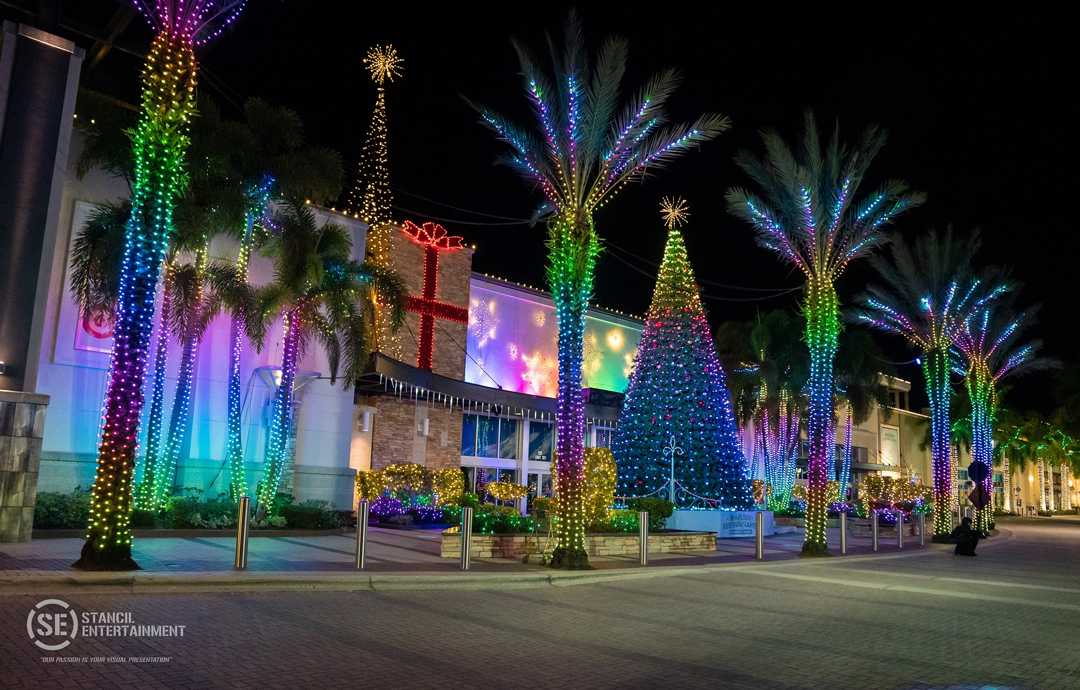Shopping mall spectacular under Obsidian control
- Details

Justin Stancil of Stancil Entertainment was contacted to design the lighting spectacular and turned to the ONYX platform from Obsidian Control Systems to control the massive system. “The client called saying they had a vision to do a big light show but had no idea how to achieve it,” Stancil shares. “I got the call in August and we designed a complete system - advanced pixels, intelligent lighting, control, hardlined and wireless networking, and automation.”
The lighting canvass, spread across a quarter of a mile square, included 200 palm trees covered in 1000 pixels each, a 50ft Christmas tree with 800 pixels, and a 34ft tree also covered in pixels.
Four Elation Proteus Hybrid luminaires washed the main Christmas tree in colour, along with other wash fixtures, and fireworks were added on some finale shows for an extra burst of excitement. Stancil put together four different shows, all about 10 minutes long, which ran every half hour between 6:30 - 9:30 pm, seven shows a night. The official launch of the new son et lumiere took place on 19 November and shows ran nightly through 3 January.
Lighting was controlled via a setup that included an Onyx PC and NX4 lighting console embedded with Obsidian’s DyLOS pixel composer. Twelve Netron EN4 and two Netron EN12 nodes, also from Obsidian, were used for data distribution. Stancil worked with Russ Brown at Freed Sales out of Orlando to secure the Obsidian equipment for Benderson Development, the development company behind the mall.
Stancil ran a custom version of Onyx with 255 unlocked universes. The show, which used a total of 215 universes, included a combination of effects from the console’s built-in DyLOS pixel composer, as well as its regular effects engine. “Because we patched every pixel in the show individually, this gave us the freedom to use DyLOS with its factory content to map video to the pixels, but also allowed us to use the standard effects engine to do precise, mathematical per pixel effects as well.”
The designer says he did not want to treat the pixels as a giant video screen using a traditional media server because of the limitations in working with video files. “If you want to do very precise, per pixel effects it is difficult,” he says. “It is much more time consuming to render video files for all effects in your show, especially when it is a less precise method to creating effects with pixel lights like these.”
Integrated into the Onyx platform, DyLOS is an intuitive toolset of media composition, effects, animations, and text generators that isn’t overly technical and eases the creative process. “As far as a pixel composer in a lighting console, there is nothing like it. Right within Oonyx and DyLOS I can treat a fixture as a standard light that color mixes but I can also treat it as a pixel in a video wall. I don't see any other consoles like ONYX that can have this type of power in an all-in-one solution.”
It also saves space in what for Stancil was an already full control rack. “If you're only mapping pixel lights, and don't have any video screens, then I don't see the need for a video server to run this type of show when you have a powerful engine like DyLOS.”
The lighting install was so massive it could only be seen in its entirety from above so Stancil took drone footage and had 15 cameras set up around the installation, also to make sure that everything ran correctly. Viewable both from a car or on foot, the light shows proved extremely popular and storefronts and restaurants, many with outside seating, were pleased with the heavy draw. “People who drove by would stop to see the show and the line of cars on nearby streets was tremendous. At times, there were so many people on foot it was hard to get from one area to another.”
















